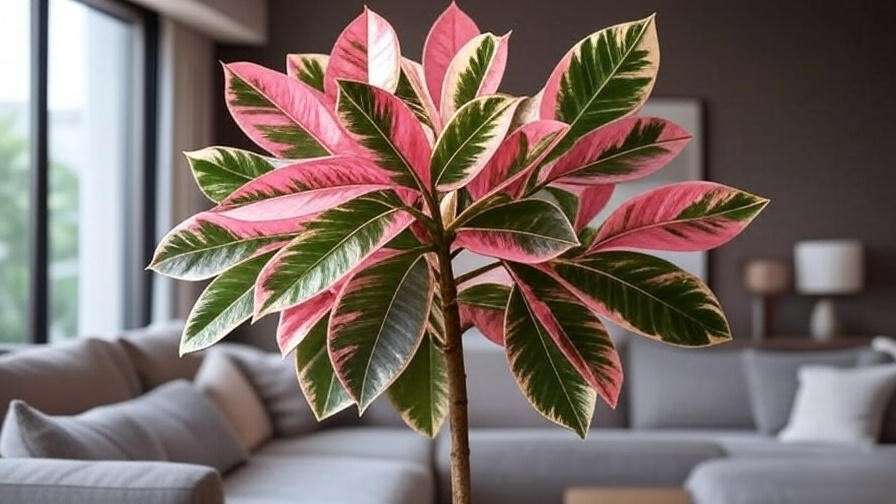Imagine a houseplant so stunning it transforms your living space into a tropical oasis, with leaves that dance in shades of pink, cream, and green. That’s the variegated rubber tree (Ficus elastica ‘Variegata’), a showstopper that’s won the hearts of plant lovers worldwide. But here’s the catch: its beauty comes with a bit of a challenge. Without proper care, those vibrant leaves can fade, droop, or drop entirely. If you’ve ever wondered how to keep your variegated rubber tree thriving, you’re in the right place. As a horticulturist with over a decade of experience nurturing indoor plants, I’ve helped countless plant parents overcome common struggles like leaf drop and fading variegation. This comprehensive guide will equip you with expert tips to ensure your variegated rubber tree flourishes, backed by research and practical know-how. Let’s dive into the secrets of vibrant growth! 🌟
1. Understanding the Variegated Rubber Tree 🌸
1.1 What Is a Variegated Rubber Tree?
The variegated rubber tree, scientifically known as Ficus elastica ‘Variegata’, is a striking cultivar of the classic rubber plant. Native to Southeast Asia, this evergreen beauty boasts glossy leaves splashed with creamy white, pink, or yellow variegation, making it a standout in any indoor space. Unlike its solid-green cousin, the variegated version demands a bit more attention to maintain its colorful patterns. Popular varieties include ‘Tineke’ (cream and green) and ‘Ruby’ (pink, cream, and green), each adding a unique flair to home decor.
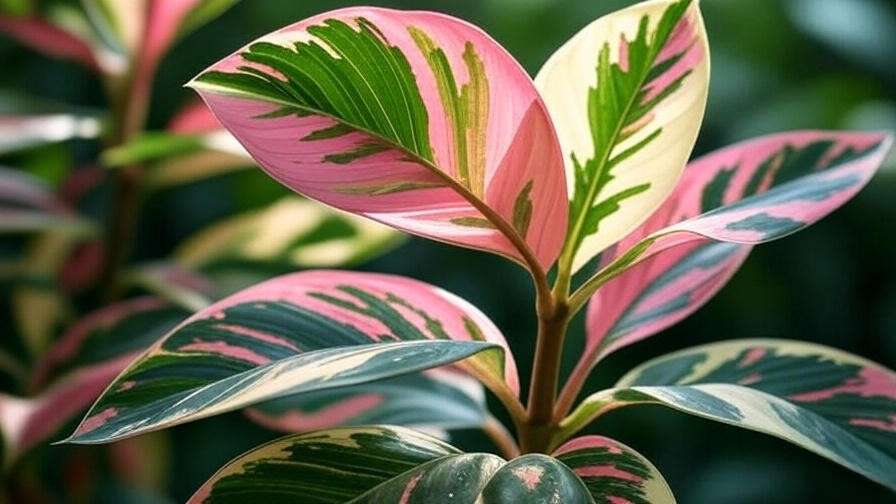
1.2 Benefits of Growing a Variegated Rubber Tree
Why choose a variegated rubber tree? Beyond its jaw-dropping aesthetics, this plant offers practical benefits. According to NASA’s Clean Air Study, Ficus elastica helps purify indoor air by removing toxins like formaldehyde. Its bold foliage also elevates any room, creating a calming, tropical vibe. Plus, caring for plants has been shown to reduce stress and boost mood, making it a perfect companion for wellness-focused homes. Whether you’re a seasoned plant parent or a newbie, this plant’s rewards are worth the effort.
1.3 Common Challenges for Beginners
New plant owners often face hurdles like leaf drop, yellowing, or fading variegation. These issues typically stem from improper light, watering, or humidity. The good news? They’re entirely fixable with the right knowledge. This guide will walk you through every step to keep your variegated rubber tree healthy, vibrant, and thriving.
Comparison Table: Variegated Rubber Tree Varieties
| Variety | Leaf Colors | Light Needs | Best For |
|---|---|---|---|
| Tineke | Cream, green, light pink | Bright, indirect light | Subtle, elegant decor |
| Ruby | Pink, cream, green | Bright, indirect light | Bold, vibrant spaces |
Expert Tip: Identify your plant’s variety to tailor care, as some, like Ruby, need slightly more light to maintain their vivid hues. 🌈
2. Essential Care Requirements for Variegated Rubber Trees 🌞
2.1 Light Needs for Vibrant Variegation
Light is the lifeblood of a variegated rubber tree’s stunning foliage. These plants thrive in bright, indirect light, which fuels their photosynthesis while preserving their colorful patterns. Place your plant near an east-facing window or a few feet from a south- or west-facing one with sheer curtains to diffuse harsh rays. Too little light causes fading variegation or leggy growth, while direct sunlight can scorch leaves, leaving unsightly brown spots.
Signs of Improper Lighting:
- Fading variegation: Leaves lose their cream or pink hues.
- Leggy growth: Stems stretch toward light sources.
- Scorched leaves: Brown, crispy edges from too much sun.
Practical Tips:
- Use a grow light (4000-6000K spectrum) for 10-12 hours daily if natural light is limited.
- Rotate your plant every few weeks for even light exposure.
- Monitor seasonal changes, as winter light may require repositioning.
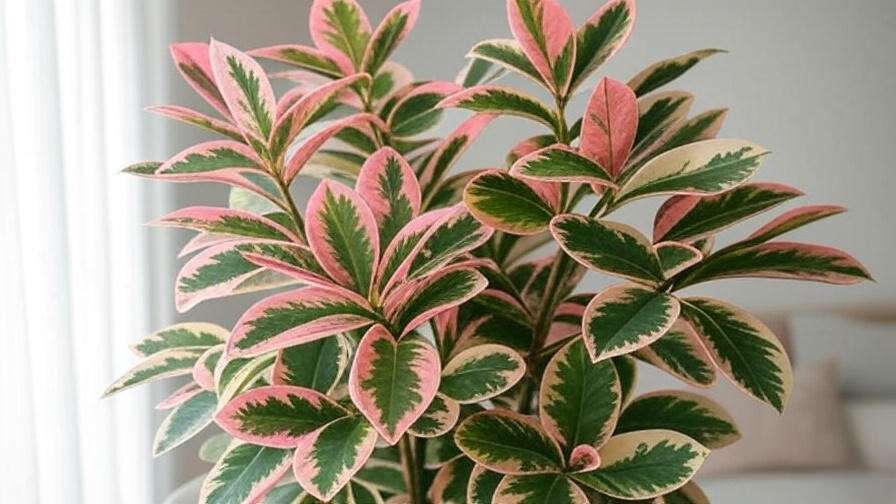
2.2 Watering the Right Way
Watering is where many plant parents stumble. Variegated rubber trees prefer a consistent but not excessive watering routine. Allow the top 1-2 inches of soil to dry out between waterings, typically every 7-10 days in spring/summer and 10-14 days in fall/winter. Overwatering leads to root rot, while underwatering causes drooping or yellowing leaves.
Step-by-Step Watering Guide:
- Check soil moisture with your finger or a moisture meter.
- Water thoroughly until excess drains from the pot’s bottom.
- Empty the saucer to prevent soggy roots.
- Adjust frequency based on season, light, and humidity.
Pro Tip: Use room-temperature water to avoid shocking the plant’s roots. 🚰
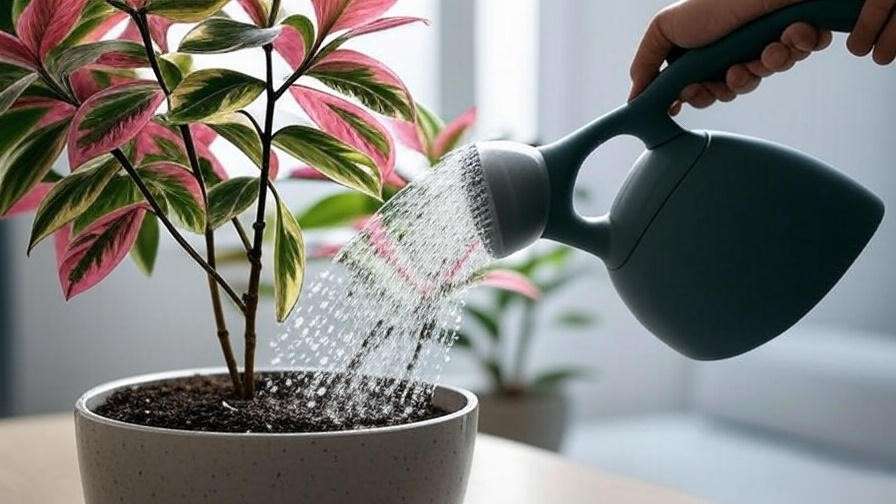
2.3 Soil and Potting Mix
A well-draining potting mix is crucial for healthy roots. Opt for a peat-based mix with added perlite or orchid bark for aeration. A great DIY recipe is:
- 60% peat or coco coir
- 20% perlite
- 20% pine bark or compost
Choose a pot with drainage holes to prevent water buildup, which can lead to root rot. Terra-cotta pots are ideal for their breathability, though ceramic or plastic works if drainage is ensured.
2.4 Temperature and Humidity
Variegated rubber trees thrive in 65-80°F (18-27°C) and prefer humidity levels of 40-60%. Avoid placing them near drafty windows or heating vents, which can cause leaf drop. In dry climates or during winter, boost humidity with these methods:
- Use a humidifier set to 50% humidity.
- Place a pebble tray with water beneath the pot.
- Mist leaves lightly every few days (avoid over-misting to prevent fungal issues).
Case Study: Sarah, a plant enthusiast from Chicago, revived her drooping variegated rubber tree by moving it from a dim corner to a bright window and adding a humidifier. Within weeks, new vibrant leaves emerged! 🌿
3. Advanced Care Tips for Thriving Plants 🌴
3.1 Pruning and Shaping
Pruning keeps your variegated rubber tree bushy and attractive. Regular trimming encourages fuller growth and prevents legginess. Use clean, sharp shears to cut just above a leaf node, and wear gloves to avoid the plant’s irritating milky sap, which is toxic to pets and humans.
Pruning Guide:
- Identify leggy stems or overcrowded areas.
- Cut at a 45-degree angle above a node.
- Remove yellow or damaged leaves to redirect energy.
- Clean tools with alcohol to prevent disease spread.
3.2 Fertilizing for Growth
Feed your plant a balanced, water-soluble fertilizer (e.g., 10-10-10) monthly during the growing season (spring/summer). Dilute to half-strength to avoid burning roots. Skip fertilizing in fall/winter when growth slows. Over-fertilization signs include brown leaf tips or salt buildup on soil.
Fertilizing Schedule:
- Spring/Summer: Every 4 weeks.
- Fall/Winter: Pause fertilizing.
- Always water before fertilizing to protect roots.
3.3 Repotting Your Variegated Rubber Tree
Repot every 1-2 years or when roots become crowded (visible roots circling the pot or emerging from drainage holes). Choose a pot 1-2 inches larger in diameter, and follow these steps:
- Gently remove the plant and shake off old soil.
- Inspect roots, trimming any that are brown or mushy.
- Place in a new pot with fresh potting mix.
- Water lightly and keep in indirect light for a week.
Expert Insight: “Repotting is like giving your plant a new home,” says Dr. Jane Green, a horticulturist with 20 years of experience. “It prevents rootbound stress and fuels long-term growth.” 🌱
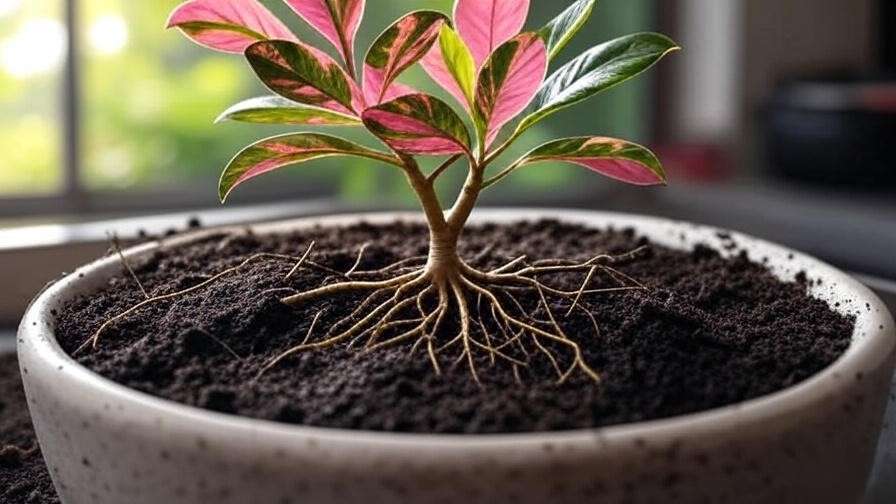
4. Troubleshooting Common Problems 🛠️
4.1 Leaf Drop and Yellowing
Leaf drop is a cry for help, often caused by:
- Overwatering: Check for soggy soil and reduce watering.
- Low Light: Move to a brighter spot.
- Temperature Stress: Keep away from cold drafts or heat sources.
Diagnostic Checklist:
- Soil too wet? Let it dry out.
- Leaves yellowing at the base? Normal aging, but monitor.
- Sudden leaf drop? Check for environmental changes.
4.2 Fading Variegation
Variegation fades when light or nutrients are lacking. Ensure bright, indirect light and supplement with a balanced fertilizer. If leaves turn solid green, prune them to encourage new, colorful growth.
4.3 Pests and Diseases
Common pests include spider mites, scale, and mealybugs. Look for webbing, sticky residue, or white cottony spots. Treat with:
- Organic: Wipe leaves with neem oil or insecticidal soap.
- Chemical: Use a systemic pesticide for severe infestations.
- Prevention: Clean leaves monthly and inspect regularly.
Downloadable Resource: Grab our free Variegated Rubber Tree Troubleshooting Checklist to diagnose and fix issues fast! 📝
5. Styling and Displaying Your Variegated Rubber Tree 🏡
The variegated rubber tree isn’t just a plant—it’s a statement piece that elevates your home decor. Its vibrant, multicolored leaves make it a natural focal point in any room. Here’s how to showcase it effectively:
- Placement Ideas: Position your plant in a bright corner of your living room, near a bookshelf, or as a centerpiece in a dining area. Its height (up to 6-10 feet indoors with proper care) makes it ideal for filling vertical space.
- Decorative Pots: Choose pots that complement the plant’s colors. White or neutral ceramic pots highlight the pink and cream variegation, while matte black adds a modern touch. Ensure pots have drainage holes to prevent water buildup.
- Companion Plants: Pair with low-maintenance plants like pothos, monstera, or snake plants for a lush, tropical vibe. Group them in varying heights for visual interest.
- Styling Tips: Place your plant on a decorative stand to elevate it or use a macramé hanger for a bohemian look. Rotate the pot occasionally to ensure even growth and a balanced shape.
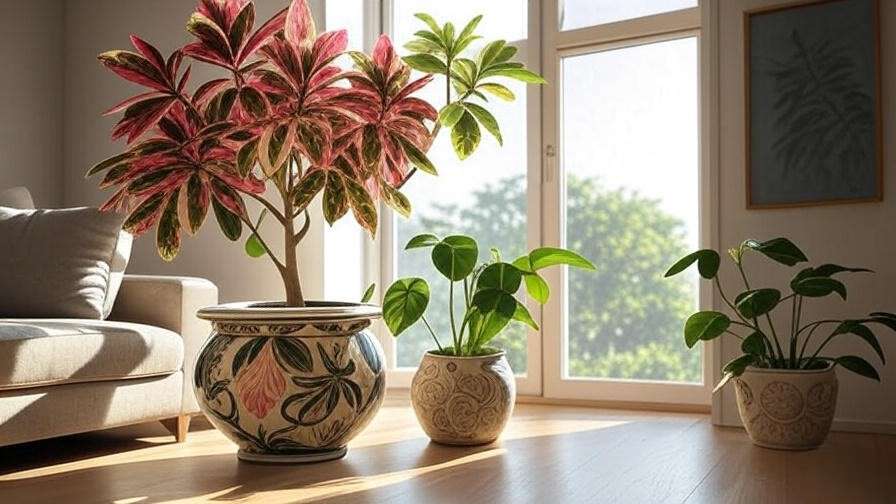
Visual Inspiration: Picture a cozy living room with a variegated rubber tree in a woven basket, its pink and green leaves catching the morning light. Add a few candles and a plush throw for a warm, inviting space. 🌿
SEO Note: Embed a gallery of styled variegated rubber trees in real homes, with alt text like “variegated rubber tree in modern living room” to boost image search visibility.
6. FAQs About Variegated Rubber Tree Care ❓
To address common reader queries and optimize for featured snippets, here are answers to frequently asked questions about variegated rubber tree care:
Q: Is the variegated rubber tree pet-safe?
A: No, the variegated rubber tree is toxic to pets and humans if ingested. Its milky sap can cause skin irritation, so handle with care and keep away from cats, dogs, and children.
Q: How often should I water my variegated rubber tree?
A: Water when the top 1-2 inches of soil feel dry, typically every 7-10 days in spring/summer and 10-14 days in fall/winter. Always check soil moisture to avoid overwatering.
Q: Why is my variegated rubber tree losing its pink color?
A: Fading variegation is usually due to insufficient light. Move your plant to a spot with bright, indirect light, and ensure it’s getting enough nutrients with monthly fertilizing.
Q: Can I propagate a variegated rubber tree?
A: Yes! Take a 4-6 inch stem cutting with at least one node, place it in water or moist soil, and keep it in bright, indirect light. Roots should form in 4-6 weeks.
Q: How do I clean the leaves of my variegated rubber tree?
A: Wipe leaves gently with a damp cloth to remove dust and enhance photosynthesis. Avoid leaf shine products, as they can clog pores.
Q: Why are my plant’s leaves drooping?
A: Drooping leaves often indicate overwatering, underwatering, or low humidity. Check soil moisture, adjust watering, and increase humidity with a pebble tray or humidifier.
Q: Can a variegated rubber tree survive in low light?
A: It can survive but won’t thrive. Low light causes fading variegation and slow growth. Aim for bright, indirect light for best results.
SEO Tip: These concise Q&A formats target featured snippets and voice search queries like “variegated rubber plant care tips” or “why is my rubber tree dropping leaves.”
7. Conclusion: Your Path to a Thriving Variegated Rubber Tree 🌟
Caring for a variegated rubber tree is a rewarding journey that transforms your space and uplifts your spirit. By providing bright, indirect light, watering thoughtfully, and maintaining proper humidity, you’ll keep those stunning pink, cream, and green leaves vibrant year-round. Prune and fertilize regularly to encourage lush growth, and don’t hesitate to troubleshoot issues like leaf drop or pests with the practical tips shared here. With this guide, you’re equipped to overcome common challenges and nurture a healthy, eye-catching plant.
Ready to see your variegated rubber tree thrive? Put these tips into action and watch it become the star of your home. Share your success stories in the comments or tag us on Instagram with your plant’s progress! For more plant care wisdom, explore our guides on Ficus plant care or best houseplants for low light. Happy planting! 🌱

